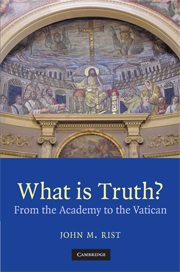Book contents
- Frontmatter
- Contents
- Acknowledgments
- Abbreviations
- Introduction: Partial and universal truth
- 1 The human race, or how could women be created in the image and likeness of God?
- 2 Divine justice and man's “genetic” flaw
- 3 Divine beauty: Nature, art and humanity
- 4 The origin and early development of episcopacy at Rome
- 5 Caesaropapism, theocracy or neo-Augustinian politics?
- 6 The Catholic Church in “modern” and “post-modern” culture
- 7 Looking at hopes and fears in the rear mirror
- Bibliography
- Index
1 - The human race, or how could women be created in the image and likeness of God?
Published online by Cambridge University Press: 05 June 2012
- Frontmatter
- Contents
- Acknowledgments
- Abbreviations
- Introduction: Partial and universal truth
- 1 The human race, or how could women be created in the image and likeness of God?
- 2 Divine justice and man's “genetic” flaw
- 3 Divine beauty: Nature, art and humanity
- 4 The origin and early development of episcopacy at Rome
- 5 Caesaropapism, theocracy or neo-Augustinian politics?
- 6 The Catholic Church in “modern” and “post-modern” culture
- 7 Looking at hopes and fears in the rear mirror
- Bibliography
- Index
Summary
Mulier non Codex
Trimalchio in Petronius' SatyriconTHE IMPORTANCE OF THE PROBLEM
Despite its gamut of heroines, the unreconstructed Old Testament preaches an essentially male religion. That is true even more of the Qu'ran, where women may be accorded a certain respect in their place, but where in subsequent law (and common practice) they are exactly half as valuable as men; as is notorious, a man may have up to four wives at a time (Mohammed himself was eventually conceded an indefinite number, plus concubines), while no woman can have more than one man at a time, who may be shared, without risking death as an adulteress. Despite the plain and remarkable attitudes of its founder, Christianity too could (humanly speaking) have become an essentially male religion, and in periods when the Old Testament (plus a few ambiguous passages of Paul) were given special weight, both in Catholicism and Protestantism – not to speak of Orthodoxy – it tended to revert to earlier Near Eastern attitudes to the relationship between man, woman and God.
In important respects such attitudes were confirmed by certain features of the Greek philosophy (not to speak of the Greco-Roman culture) that lent Christianity so much help in the formulation and development of its dogmas. So that it is of particular interest for any study of the development of Catholic culture that Catholic Christianity has eventually not become a “male” religion.
- Type
- Chapter
- Information
- What is Truth?From the Academy to the Vatican, pp. 18 - 103Publisher: Cambridge University PressPrint publication year: 2008

